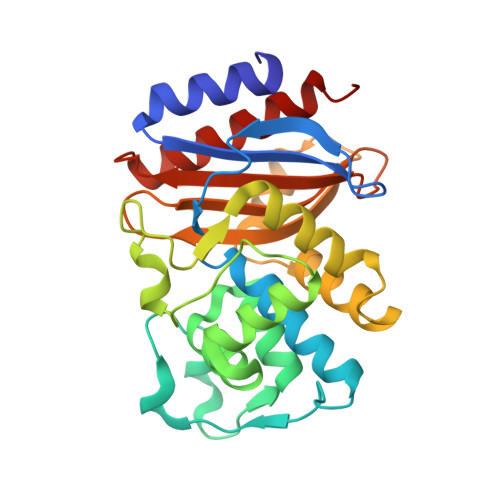Crystal structure of a pre-acylation complex of the beta-lactamase inhibitor, sulbactam, bound to a sulfenamide bond containing thiol-beta-lactamase
Rodkey, E.A., Drawz, S.M., Sampson, J.M., Bethel, C.R., Bonomo, R.A., van den Akker, F.(2012) J Am Chem Soc 134: 16798-16804
- PubMed: 22974281
- DOI: https://doi.org/10.1021/ja3073676
- Primary Citation of Related Structures:
4FD8, 4FH2, 4FH4 - PubMed Abstract:
The rise of inhibitor-resistant and other β-lactamase variants is generating an interest in developing new β-lactamase inhibitors to complement currently available antibiotics. To gain insight into the chemistry of inhibitor recognition, we determined the crystal structure of the inhibitor preacylation complex of sulbactam, a clinical β-lactamase inhibitor, bound in the active site of the S70C variant of SHV-1 β-lactamase, a resistance enzyme that is normally present in Klebsiella pneumoniae. The S70C mutation was designed to affect the reactivity of that catalytic residue to allow for capture of the preacylation complex. Unexpectedly, the 1.45 Å resolution inhibitor complex structure revealed that residue C70 is involved in a sulfenamide bond with K73. Such a covalent bond is not present in the wild-type SHV-1 or in an apo S70C structure also determined in this study. This bond likely contributed significantly to obtaining the preacylation complex with sulbactam due to further decreased reactivity toward substrates. The intact sulbactam is positioned in the active site such that its carboxyl moiety interacts with R244, S130, and T235 and its carbonyl moiety is situated in the oxyanion hole. To our knowledge, in addition to being the first preacylation inhibitor β-lactamase complex, this is also the first observation of a sulfenamide bond between a cysteine and lysine in an active site. Not only could our results aid, therefore, structure-based inhibitor design efforts in class A β-lactamases, but the sulfenamide-bond forming approach to yield preacylation complexes could also be applied to other classes of β-lactamases and penicillin-binding proteins with the SXXK motif.
Organizational Affiliation:
Department of Biochemistry, Case Western Reserve University, 10900 Euclid Avenue, Cleveland, Ohio 44106, USA.
















